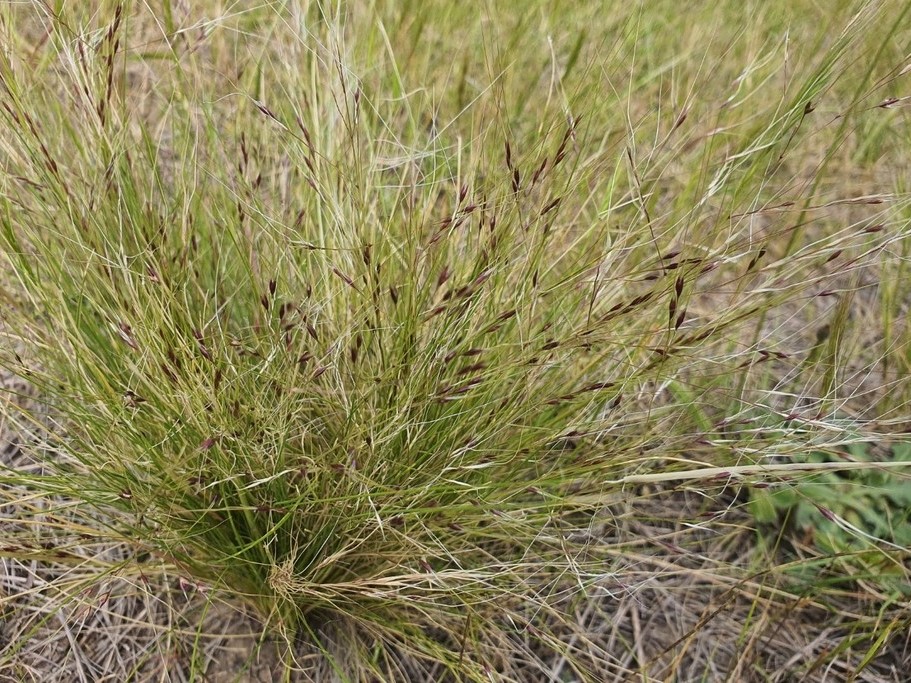Created by: Lauren Quon
Created on: Thursday, Dec 7th, 2023
Created on: Thursday, Dec 7th, 2023
Yes or No:
Yes
Points:
1
Confidence Level:
High
Answer / Justification:
Serrated tussock is native to South America, but has become naturalized in Australia and South Africa (Invasives SA 2021, Government of South Australia 2015).
Reference(s):
Yes or No:
Yes
Points:
2
Confidence Level:
High
Answer / Justification:
Serrated tussock is naturalized in Australia and South Africa, which have similar climates to the US (Invasives SA 2021, Government of South Australia 2015). According to the Flora of North America, it is on the USDA's noxious weed list in the US.
Reference(s):
Yes or No:
Yes
Points:
2
Confidence Level:
Very High
Answer / Justification:
Serrated tussock is invasive in the US, where it is considered invasive in Illinois, Kentucky, North Carolina, South Carolina, Arizona, Florida, Hawaii, and Texas (Flora of North America 2021, CABI 2019, USDA-NRCS 2004, Texas invasives).
Reference(s):
Yes or No:
Yes
Points:
3
Confidence Level:
Very High
Answer / Justification:
Serrated tussock is on the USDA's noxious weed list. The Flora of North America identifies it's occurrences in Illinois, Kentucky, North Carolina and South Carolina. CABI and Texas invasives.org lists this species as invasive in the following states: Arizona, Florida, Hawaii, Texas, and North Carolina.
It is also considered invasive in in Australia, New Zealand, and South Africa, areas of similar climates (also see climate matching map attached and linked).
Reference(s):
Yes or No:
Yes
Points:
1
Confidence Level:
High
Answer / Justification:
Nassella tenuissima, Mexican feather grass has similar features and is considered an invasive garden plant by some horticultural media. It is naturalized in Arizona, as an ornamental grass (CABI 2019).
It was introduced in Belgium, UK, Australia, and South Africa, where Australia and South Africa are areas of similar climates to California.
Reference(s):
Yes or No:
No
Points:
0
Confidence Level:
Medium
Answer / Justification:
In its native range in South America, it occurs mostly where climate does not match California. Outside of its native range, it is found in Madagascar, Europe, South Africa, Australia, and other parts of North America, where climate often does not match California.
Link to climate matching map: https://weedmap.cal-ipc.org/climatematch/?areaType=states&areaList=06&mapView=2%2C0.00000%2C0.00000&datalayer=COMBINED&datalayeropacity=60&gbif_taxonkey=9613389&gbif_search=nassella+trichotoma&gbif_speciesname=Nassella+trichotoma
Reference(s):
Yes or No:
Yes
Points:
1
Confidence Level:
High
Answer / Justification:
Many sources state that serrated tussock grass invades pastures and can cause livestock production loss in temperate grasslands due to it being left ungrazed (Humphries 2020, CABI 2019, Weeds of Australia 2016, Government of South Australia 2015). If left ungrazed, serrated tussock can continue to spread into open spaces and displace native grass and other species (Humphries 2020, CABI 2019). In native grasslands and coastal vegetation, serrated tussock displaces native grass and degrades fauna habitat (Government of South Australia 2015).
Reference(s):
Yes or No:
Yes
Points:
1
Confidence Level:
High
Answer / Justification:
Serrated tussock grass fields can promote fire/be a fire hazard, especially infestations in the wildland-urban interface, where houses or other infrastructure borders infested areas (Government of South Australia 2015).
Serrated tussock grasses can establish in post-fire bare ground areas and grows vigorously after it is burned (Victorian Serrated Tussock Working Party 2023).
Reference(s):
Yes or No:
Yes
Points:
1
Confidence Level:
High
Answer / Justification:
Serrated tussock grass is high in fibre, but low in protein, which can cause indigestible balls in livestock rumen and eventually lead to loss in livestock (CABI 2019, Government of South Australia 2015). Serrated tussock grass, if left ungrazed, can reduce up to 97% of losses in livestock production (CABI 2019).
Reference(s):
Yes or No:
No
Points:
0
Confidence Level:
Medium
Answer / Justification:
Serrated tussock grass may be evenly distributed throughout an area, and would be unlikely to block or slow movement of animals, livestock, or humans. Current literature implies that it does not form thickets, but rather spreads out over bare ground and disturbed pastures (Humphries 2020, CABI 2019). Serrated tussock forms tussocks up to 50 cm tall and 25 cm across at the base, but it's unclear whether plants form dense, impenetrable thickets (CABI 2019, South Australia 2015).
Reference(s):
Yes or No:
No
Points:
0
Confidence Level:
Very High
Answer / Justification:
Sources indicate that serrated tussock reproduces and grows from seed (Humphries et al 2020, CABI 2019, Weeds of Australia 2016). Serrated tussock is not rhizomatous, so vegetative spread is also unlikely (Flora of North America 2021).
Reference(s):
Yes or No:
No
Points:
0
Confidence Level:
Very High
Answer / Justification:
Sources indicate that new plants come from seeds (Humphries et al 2020, Weeds of Australia 2016). Serrated tussock is not rhizomatous, so vegetative spread is also unlikely (Flora of North America 2021).
Reference(s):
Yes or No:
Yes
Points:
1
Confidence Level:
High
Answer / Justification:
Serrated tussock individuals may produce over 100,000 (up to 140,000) seeds that are mostly viable (Humphries 2020, CABI 2019, South Australia 2015). Seeds are viable, with germination at 50% after 5 days, but seed viability decreases over the span of 12 months, where less than 10% of seeds may be viable (Humphries and Florentine 2022).
Reference(s):
Yes or No:
Yes
Points:
1
Confidence Level:
High
Answer / Justification:
Each plant produces more than 100,000 seeds, and up to 140,000 seeds annually (Humphries et al 2020, Government of South Australia 2015). Seed viability is noted as high within the first 5 days, but decreases over time (Humphries and Florentine 2022).
Reference(s):
Yes or No:
Yes
Points:
1
Confidence Level:
Medium
Answer / Justification:
Germination generally occurs throughout the year, but can increase if there is soil disturbance or fire. Drought and salinity can decrease germination (Humphries et al 2020). Though most seeds germinate within 6-12 months, some seeds may be dormant, or have staggered dormancy periods to ensure germination over time (Humphries et al 2020, CABI 2019).
Reference(s):
Yes or No:
Yes
Points:
1
Confidence Level:
Very High
Answer / Justification:
Serrated tussock reproduces and mainly grows from seed, and one plant may produce over 100,000 (up to 140,000) seeds that may be distributed by animals, wind, or water (Humphries and Florentine 2022, Humphries et al 2020, Government of South Australia 2015). Seed banks are viable for up to 3 years (Humphries and Florentine 2022).
Reference(s):
Yes or No:
Yes
Points:
1
Confidence Level:
Medium
Answer / Justification:
Serrated tussock may produce seed for more than 3 months each year, with seed production occurring between October through April, after flowering from August through May (Victorian State Government 2020).
Reference(s):
Yes or No:
Yes
Points:
1
Confidence Level:
High
Answer / Justification:
Seeds can be dispersed by livestock when they get stuck on livestock fur coats or mud hooves (Government of South Australia 2015).
Reference(s):
Yes or No:
Yes
Points:
1
Confidence Level:
High
Answer / Justification:
Serrated tussock seeds can be dispersed by wind or water, but it is unknown if they travel long distances (CABI 2019, Weeds of Australia 2016, Government of South Australia 2015). We can assume that seeds can be dispersed long distances due to size and structure, which may increase mobility.
Reference(s):
Yes or No:
Yes
Points:
1
Confidence Level:
High
Answer / Justification:
Plant seeds can be dispersed by contaminated machinery and equipment, hay, footwear, and clothing (Government of South Australia 2015). Frequency of distribution is unknown, but seeds are likely dispersed frequently in areas where plants are numerous.
Reference(s):
Notes:
- < 13 : Low Potential Risk
- 13 - 15 : Moderate Potential Risk
- > 15 : High Potential Risk
PRE Score:
20
Number of questions answered:
20
Screener Confidence (%):
81.0
Evaluation visibility:
Public - accessible to all site users

